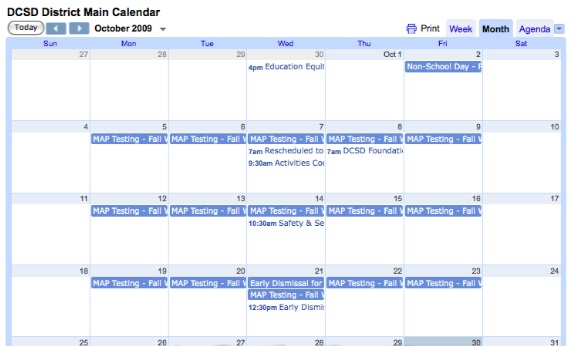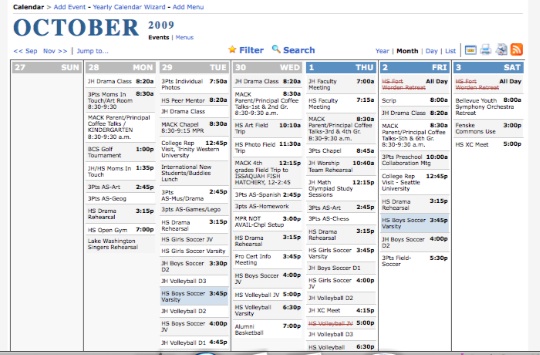Software is increasingly changing the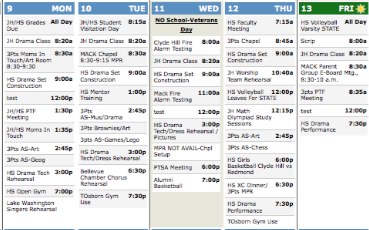 way we perceive common tools of everyday life such as books and calendars. Before a computer became common in every home and classroom, we were accustomed to paper based systems for activities such as reading or finding out what events are happening at school. Just as the Kindle for the iPod has altered the book industry by enabling almost instant access to millions of books, Intand’s school calendar software, Tandem for Schools, has transformed the way school administrators, teachers, students, and parents interact with the school calendar. And like other tools in society that have been replaced by software, school calendar software has many advantages.
way we perceive common tools of everyday life such as books and calendars. Before a computer became common in every home and classroom, we were accustomed to paper based systems for activities such as reading or finding out what events are happening at school. Just as the Kindle for the iPod has altered the book industry by enabling almost instant access to millions of books, Intand’s school calendar software, Tandem for Schools, has transformed the way school administrators, teachers, students, and parents interact with the school calendar. And like other tools in society that have been replaced by software, school calendar software has many advantages.
Eliminate paper-based systems
Paper based calendars are not very efficient by today’s standards. Traditionally school districts may have sent out a paper annual calendar to all students families. These calendars would be pretty empty except for school holidays. Many schools would also send out a monthly newsletter or flier home with students that described upcoming events. This would often require hundreds or thousands of pages of paper to be printed out, and often the information was out of date as soon as it was received. School calendar software like Tandem for Schools allows schools to publish events to an online calendar that is instantly accessible to everyone who goes to the calendar’s web page on their internet browser. This can also save lots of paper and ink.
Increased event awareness
Another advantage of school calendar software is that it can raise awareness of what is going on at the school. While a paper calendar that you stick to your fridge can be a reference for what events are happening at the school, a calendar that sits on a web page can be far more informative. An online school calendar can show every event that is going on at the school with detailed information about the place, time, directions, contacts, etc. Instead of a sheet of paper that can be lost in transit or misplaced, Tandem for Schools is always accessible from anywhere you have access to the internet. Students and parents always know where to go to find out what is happening at the school, which encourages school participation.
Improved School Facilities Management Process
Before school calendar software solutions like Tandem, managing and scheduling use of school facilities could be a major project. The school administrator may have to account for a large number of school groups and scheduling conflicts could be common. Requesting use of a facility could take days or weeks, with the back and forth phone tag or email tag. Tandem for Schools makes this facilities management easy with automatic conflict detection, and a simple and streamlined facilities request and approval process.
Real Time Information Updates
If there is a change in the time of an event, or a school cancellation due to inclement weather, Tandem for Schools can display this change on the main calendar almost instantly after a school administrator makes the change. In contrast a paper calendar takes a very long time to update and is useless for school cancellations or same day changes. Being able to check the status of an event or school cancellation online is very convenient to parents and can prevent lots of phone calls to the office. With Tandem for Schools, parents can also sign up for automatic email updates when the status changes for an event.
There are many other benefits of school calendar software compared to paper-based calendars. If you would like to learn more, sign up for a free demonstration of Tandem for Schools.
Tandem Tidings: Our New Newsletter
Intand will be sending out a monthly newsletter, Tandem Tidings, to Tandem administrators with tips, news, and helpful information about using Tandem’s school calendar software. Here are a few snippets from the newsletter:
Message From Intand’s President
It seems like just yesterday that we were starting up Intand in Bellevue, Washington with the hopes of getting 10-15 school districts on board. Over the past 5 years, we have grown much larger than 10-15 districts! Currently, Tandem is being used by districts in 44 states! Along the way, we have been able to collect a fantastic team at Intand who are truly dedicated to your school and district. We hope you have enjoyed using Tandem to connect with your parents and organize your school as much as we have enjoyed serving you. If you aren’t already, please consider using Tandem district-wide, for all of your schools and all of your events. In this past year, we have seen a significant difference in the districts who are using Tandem district-wide as opposed to using it only at 1-2 schools. Talk to your support representative about how to get started on this; it’s easier than you think! In all of this, we hope to be making your jobs easier, so you can spend time on what is important this season. Enjoy your Thanksgiving and Christmas and all the joyous holidays of the season!
Warmly,
Bryan Otis
Upcoming Webinars
Ongoing training is very important. We know that changes occur in your staff and faculty, people come and go and we are here to get those new and infrequent users up to speed. In addition to our customized paid training sessions, we offer a free weekly webinar called the Tandem Genius Series. The weekly topics are posted on our website, www.intand.com in the Support section and you can pre-register for the sessions that you’d like to learn more about.
Nov. 18th Requesting Transportation & Adding a Trip (Tandem Plus Users)
Nov. 25 Schedules, make them your friend!
Tandem Referral Program
Our success is attributed in large part to users like yourself. Many of you have spread the word and shared your Tandem experience with other schools and districts.
As a Thank You we are offering you an extended subscription. From now until the end of the year, if you refer a school or district and they sign up for a Tandem Standard or Tandem Plus subscription, we will add 1 month to the end of your subscription free of charge! There is no limit—so if you refer 5 schools that sign up, you will receive an additional 5 months to your subscription for FREE. Simply send an email to support@intand.com and tell us who you have referred so your school will get the credit.
Share Your Story
Would you like to share your success story and gain global recognition for your school or district? We are working on new case studies, or success stories as we are calling them, to show the world how Tandem for Schools has made a difference for you, your school, and your community. Have you:
- Established consistency and a fair process for managing facilities?
- Reduced scheduling conflicts?
- Eliminated paper-based systems?
- Increased event awareness?
- Improved communication between faculty and staff?
- Become more efficient?
- Improved your image and made a stronger community?
This would be a great opportunity for your journalism class or club to conduct interviews off and on camera! If you don’t have a journalism group, no problem! A member from the Tandem support team will conduct the brief interview and get the story ready for publishing on our website. Just let us know if you are interested and we will guide you through the short and simple process from start to finish.
E-Readers in Education
 Within a relatively short time frame, Amazon.com launched the Kindle followed by Kindle 2 and Sony launched its latest electronic reader. On the heels of these two revolutionary e-readers, Barnes & Noble will be releasing Nook, their version of an electronic book. Unlike e-readers of the past, these new models offer many features that have school systems and some education advocates pondering whether Kindles or other e-readers should be incorporated into the classroom either in place of or as a supplement to traditional textbooks.
Within a relatively short time frame, Amazon.com launched the Kindle followed by Kindle 2 and Sony launched its latest electronic reader. On the heels of these two revolutionary e-readers, Barnes & Noble will be releasing Nook, their version of an electronic book. Unlike e-readers of the past, these new models offer many features that have school systems and some education advocates pondering whether Kindles or other e-readers should be incorporated into the classroom either in place of or as a supplement to traditional textbooks.
E-Readers offer numerous benefits when incorporated into a classroom setting or an entire educational system. These benefits range from economics to quality of learning and are far reaching enough to demand an audience.
In terms of finances, a standard e-reader will run between $200-300 at current prices. In a public school system, students are typically issued at least six textbooks (math, grammar, literature, science, social studies, an elective, and the potential seventh alternate – health) per year. At an average cost of $75-$100 per new textbook, the e-Reader (even after books were purchased and loaded) would be a comparable price and certainly no more expensive.
A major benefit of using an e-reader in the classroom shines through when one considers the publication date of textbooks. In many schools most textbooks are used for several years in a row. As physical books they cannot be updated and are used even after they are no longer current or are out of date altogether. If e-readers were utilized the books could be updated electronically as new editions were available and cutting edge scientific discoveries or important current events could be studied through publisher provided enhancements.
Another advantage shows up under the heading of note taking. In primary education, students are typically not allowed to write in books or highlight within the text and instead rely on taking pen and paper notes referencing particular passages to study or vocabulary words to look up. With an e-reader, pen and paper notes can become obsolete as a student can digitally underline or highlight important passages and use marginal notations to add supplemental information provided during lectures. Since personalized notes can be stored in a “cloud” provided by the e-Reader manufacturer, if a device malfunctioned this material could be restored. A student could rest assured they would maintain all of their notes from the beginning of a school course to the end within their e-textbook.
E-Readers take nothing from the current educational system but stand to add a lot to the learning experience. In terms of portability, value, and capability, e-Readers could be the next necessity in the classroom and the educational system at large.
Photo credit http://www.flickr.com/photos/ivyfield/ / CC BY 2.0
1. Easily access the calendar from any web browser
Tandem for Schools is a web based online calendar so parents can access the calendar by simply going to the school’s unique URL. This enables parents to be able to access the school’s calendar from any location even if it’s not their own computer. You can also access it from mobile devices with an internet connections like an iPhone or Blackberry.
2. Filter events
Schools that use Tandem for Schools often add all events for the entire school on the main school calendar. If you are a parent that is only interested in specific groups that your child belongs to such as varsity soccer or drama, you can easily filter the view to show only these events.
3. Search events
If there is a specific event that you want to find more information on Tandem has a useful search feature. Say you wanted to see what concerts were coming up. Just type in “concert” in the search box and Tandem will show all the concerts.
4. Obtain detailed information about an event
By clicking on an event on the calendar you can see a more detailed view with information like participants, contacts, supervisors, miscellaneous info, and trip information if applicable.
5. Export individual events to your personal calendar
From the individual event view you can export the event into your personal calendar such as Outlook, iCal, Google Calendar, or Cozi.
6. Synchronize your personal calendar with the school events you are interested in
Tandem allows you to sync with your personal calendar like Outlook, iCal, Google Calendar, and Cozi. It can automatically post events that you have filtered on your Tandem Calendar to your personal calendar.
6. Keep track of groups you are 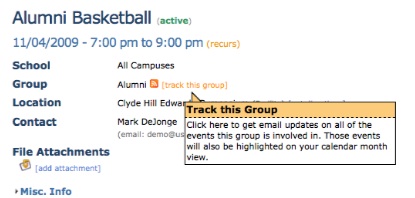 interested in
interested in
Another useful feature of Tandem for Schools is the group tracking feature. If you are logged in and view a specific event, you can click on “track this group”. You will receive email updates of events that this group is involved in, including any changes that are made.
7. Get directions to an event
Simply click on the “get directions” link on the event detail view and Tandem will redirect you to Google Maps with the event destination already filled in.
8. Set a reminder for an event
Busy parents can have a hard time remembering all the events that their children are involved in. Tandem for Schools can send you an email to remind you of a specific event. Simply log in, click on an event, and click “set reminder”. You can specify the time that you want the reminder sent, such as 2 hours before the event, and a notification will automatically be sent to your email.
If you are a parent who would like their school calendar to do more, you can request that your school consider Tandem for Schools here.
WordAhead: Vocabulary Video Site For Students
WordAhead is a vocabulary word centered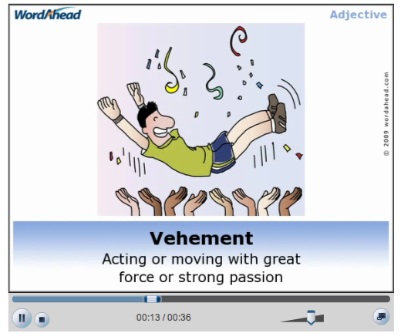 website sure to be of help to any student who wants to do well on state administered standardized tests, the SAT, or ACT as well as increase their personal vocabulary. The WordAhead premise is a simple one. The site provides a video featuring each vocabulary word on the site and its definition. A casual user can utilize the site very passively by signing up for a word-a-day email, but there are also several unique features at WordAhead to allow a more active learner to get ahead.
website sure to be of help to any student who wants to do well on state administered standardized tests, the SAT, or ACT as well as increase their personal vocabulary. The WordAhead premise is a simple one. The site provides a video featuring each vocabulary word on the site and its definition. A casual user can utilize the site very passively by signing up for a word-a-day email, but there are also several unique features at WordAhead to allow a more active learner to get ahead.
At Wordahead, scientific studies emphasizing the importance of repetition as a learning device have been taken fully into account. During the videos presented for almost all vocabulary words, the actual word is repeated several times. A video for a word such as “adjourn” will start with the word being presented with its full definition while the information is also read aloud. Then, a still cartoon image is shown to illustrate the meaning of the word while several sentences are read presenting the word in context. In many of these sentences the word will be used at least twice and typically in multiple tenses (i.e. present and past tense).
A multitude of vocabulary words and definitions are presented on the site and many students will likely find that they are already familiar with certain words and do not need to thumb through them on every visit to the site. In this instance, a free Wordahead account can be created which will allow any user to create a customized word list featuring as many or as few definitions as needed.
When a customized word list is toggled from the drop down menu at WordAhead, the videos will automatically begin to play in the browser window. This feature can also be used by a teacher to create a word list centered around a current lesson plan or as a study aid for an upcoming test. Any vocabulary list can be shared with other WordAhead members through the use of a class specific name like “Mrs. White English I, Test 3 Word List.”
These customization features and the targeted word repetition, featuring learning through hearing a vocabulary word in context and seeing an illustration while reading the word’s definition, makes WordAhead a unique educational resource.
This post is brought to you by Tandem Online School Calendar. Try the free annual school calendar here.
Google Calendar Versus Tandem for Schools
Edutopia has an article about using Google Calendar as your school calendar titled Online Calendars: Virtual Schedules Help Busy Educators.
“The first tool I’d like to explore is the online calendar. Keeping an electronic calendar is nothing new, but you’d be surprised at how few people use one. It took me several years to let go of my paper-based day planner, but once I settled into the digital-calendar world, I never looked back.”
Google Calendar is a great improvement over a static page that lists key dates for the school year, which may or may not be accurate. Google Calendar is a free online calendar web application that is easily accessible to parents, students, and staff by going to the designated web page. It can also be embedded directly on a web page. In short, it is a quick and easy solution for a basic web calendar.
While Google Calendar is a good basic calendar, it lacks a lot of functionality that schools needs to manage school events and facilities. Tandem was designed specifically with schools in mind, so it performs several functions that help make school administrators jobs easier and helps communicate school information more effectively to staff, students, and parents.
Making School Administrators Jobs Easier
Tandem for Schools goes way beyond Google Calendar, with a built in request system that streamlines facilities requests. School staff simply logs in and clicks on “Submit Event Request” from the “Requests” section of the dashboard. The administrator in charge of the calendar simply receives the requests and can approve or deny it. There’s no paperwork or phone/email tag needed. Tandem automatically checks for any schedule conflicts, avoiding double booking of facilities. This system makes it much easier to coordinate the multiple sports teams and other school groups.
It is also very simple to make changes to the calendar, when times change, and parents and students see those changes reflected right away. Schools have reported much fewer phone calls because there is a simple real time source of information for parents.
Tandem for Schools has a dedicated support staff that will help you get up and running fast and answer any of your questions.
Communicate More Effectively
While Google Calendar is a good basic internet calendar, it can be hard to read at times, since the name of the event often gets cut off. Google Calendars boxes are a fixed size so it can quickly get cluttered and unreadable. Tandem for Schools has a better design and layout from a usability standpoint with boxes that expand dynamically so that you can easily read all the event names. It is also easy for viewers of Tandem for Schools to filter the calendar to show only events that are relevant to them. Since Tandem for Schools is much less cluttered than the Google Calendar, you can fit a lot more events on the Tandem for Schools calendar. This helps everyone get a big picture of everything that is going on at the school, which encourages students and parents to get involved in extracurricular activities.
An example of a school using Google Calendar:
Tandem for Schools Calendar:
Interested in learning more? Sign up for a free 1 on 1 demo on your computer (via Go To PC) or sign up for a free 30 day trial of Tandem Plus.
Useful Tools For School English Projects
English classes generate some of the more complex pieces of homework students are assigned during primary and secondary education. Between book reports, essays, creative writing challenges, and research papers, English demands a lot of time and effort be put forth in both the actual crafting of meaningful paragraphs and the research behind each assignment. Technology has presently caught up with the challenges issued by English teachers and several exceedingly handy tools can be utilized by students to expedite and organize their English assignments no matter the scope.
Finding a wide variety of credible sources for a research paper can be a daunting task for the best of students as many basic internet searches can pull up results that are either mostly irrelevant to the particular topic or do not contain enough verified information. Ultimate-research-assistant.com helps clear through some of the clutter by compiling the results of a search in an easy to read summary format in addition to providing a list of clickable links for additional research. A tag cloud featuring the search results is also presented in the right hand margin of the page and can provide insights into additional keywords to search out or topics to explore.
Zotero.org features a handy tool to expedite crediting sources used while writing a res earch paper. Zotero is a Mozilla Firefox extension that can be utilized as sources are gathered online. The extension will help compile data and create a properly formatted Bibliography in several different styles. By progressing with the bibliography as research material is acquired, students will not have to frantically scramble to identify which source provided what information from where. When the research paper is done, a simple copy and paste will suffice for creating a well-structured Bibliography.
earch paper. Zotero is a Mozilla Firefox extension that can be utilized as sources are gathered online. The extension will help compile data and create a properly formatted Bibliography in several different styles. By progressing with the bibliography as research material is acquired, students will not have to frantically scramble to identify which source provided what information from where. When the research paper is done, a simple copy and paste will suffice for creating a well-structured Bibliography.
Rhymezone is a fairly basic web-site as far as an online dictionary and thesaurus goes, but its real s![]() hining point exists in the assistance it provides for creative writing tasks or research papers. The site features a robust rhyming dictionary to help find the perfect word to close up a couplet, and the synonym and antonym feature brings up a variety of words to use when avoiding redundancy is key.
hining point exists in the assistance it provides for creative writing tasks or research papers. The site features a robust rhyming dictionary to help find the perfect word to close up a couplet, and the synonym and antonym feature brings up a variety of words to use when avoiding redundancy is key.
Simplifying some of the more complex components of a research paper or creative writing assignment using the educational tools presented above can help any student get a step ahead in English class.
25 Essential Teacher Blogs
Here is a collection of useful and interesting blogs by teachers.
1. Cool Cat Teacher
2. Bud the Teacher
3. Christopher D Sessums
4. Hip Teacher
5. NYC Educator
6. The Daily Grind
7. Dave’s Educational Blog
8. Bionic Teaching
9. 2 Cents Worth
10. Making Teachers Nerdy
11. Teachers Count
12. The Dream Teacher
13. 21st Century Learning
14. PE for Children
15. Artichoke
16. Creating Lifelong Learners
17. The Elementary Educator
18. Teachers at Risk
19. Think Like a Teacher
20. Free Technology for Teachers
21. I Want to Teach Forever
22. Learn Me Good
23. Epic Adventures Are Often Uncomfortable
24. Sustainably Digital
25. Dangerously Irrelevant
Useful Wiki Application For School Note Taking
Springnote is an free full-feature d virtual notebook sure to inspire students and educators to greater levels of task and time organization, which in turns enhances learning. Anyone can create a Springnote account with a minimum of information.
d virtual notebook sure to inspire students and educators to greater levels of task and time organization, which in turns enhances learning. Anyone can create a Springnote account with a minimum of information.
The site allows members to enter a unique name which will then become a personalized URL. For example, “your name” would become http://www.yourname.springnote.com. At these personalized URLs a member’s notebooks are viewable to the individuals selected. Notebooks can either be private, shared with selected people, or entirely public. Each notebook can also contain numerous pages which can be assigned individual sharing rights.
A student could use one Springnote notebook to keep a detailed to do list of tasks for both home and school and make this list private while collaborating with a friend on a separate notebook page for a science project. Teacher’s could also use the service in a similar fashion and create virtual notebook pages for each school subject taught and provide a handy online assignment list for each course. The contents of these subject pages could be shared with the entire class with a few clicks of the mouse.
If a multitude of notebook pages exist, then the Springnote tagging feature will help ease clutter. Users can assign specialized tags to each notebook page to group like materials together. An additional organizational feature sure to help out is the ability to link any item on a list or notebook page to another page within Springnote. A general class assignment, like a term paper, would appear on the English class assignment list and can link to a “Term Paper” notebook page full of additional requirements or preliminary notes.
Springnote users can also accomplish several other necessary tasks like attaching videos, pictures, or files to a specific notebook page with a couple of clicks. Formatted tables, equations, and maps can also be inserted in a snap from the notebook page header.
When any assignment or task is completed the notebook owner can either strike-through the entry, highlight it in a variety of colors, or simply use the delete or backspace key – any option will work. Springnote is full of unique options for students and teachers. The site can easily become a virtual notebook, agenda, and planning desk in a matter of minutes for any user.

It’s fascinating to see how people are finding ways to use social tools like Twitter for good works. Drew Carey has pledged $1 for every Twitter follower of @drewfromtv until the end of 2009 up to $1 million to be donated to LiveStrong. Now, CollegeScholarships.org is giving away $14,014 in scholarships for the best 140 character “essay” on “how we can use Twitter to improve the world”. See the following article from Open Education for more on this.
Are you still new to the Twitter process? Ever wondered if t hat Tweet-texting your son or daughter was doing would ever amount to anything useful?
hat Tweet-texting your son or daughter was doing would ever amount to anything useful?
Well, now you just may see some possible value in what that college-age son or daughter has been up to. Given our love for all good things free, we could not help but point folks in the direction of CollegeScholarships where the site supporters are offering $14,014.00 in scholarships for the best in Tweeting.
It is a contest that would make any English teacher proud, as in how can one say something extremely profound in just a few words. Given that “Twitter is Connecting the World,” the assignment is simple, “in 140 characters or less, write a Tweet highlighting how we can use Twitter to improve the world.”
OK, so it’s not so easy.
But it is a helluva an idea backed by some serious generosity.
And yes, it looks like there just might be a theme here: the total prize money, $14,014.00, seems to highlight a certain three-digit number.
The details on the 140 Scholarship can be found here.
This post has been republished from Open Education. Photo from Smashing Magazine.
